Leave the skin on
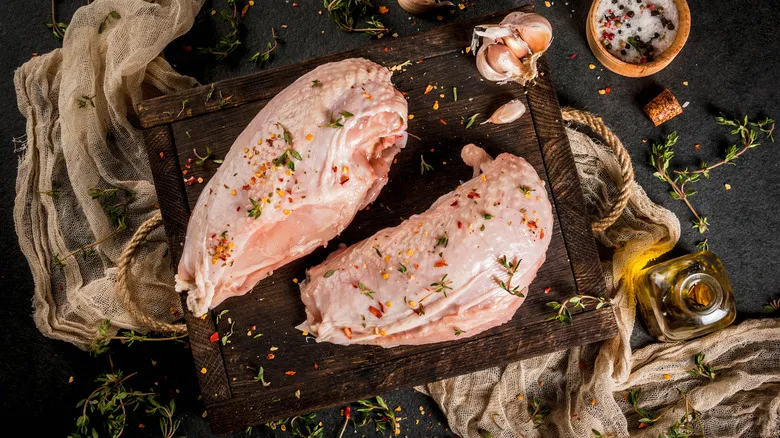
Many people opt for boneless, skinless chicken breasts because they appear simpler to cook and are often viewed as healthier. While they are lower in fat, the downside is that they tend to lack flavor. The bones and fat in chicken skin contribute to the bird's taste and moisture. Additionally, when cooked properly, the skin can become crispy and delicious. If strict low-fat eating isn't your main focus, consider choosing bone-in and/or skin-on chicken breasts during your next visit to the butcher. These cuts are not only more flavorful but also present beautifully on the plate with their seasoned, crispy skin.
Celebrity chef and cookbook author Ina Garten shares her reasoning for keeping the skin on chicken breasts. The skin helps prevent the meat from drying out in the pan or oven and retains more juices. Even if you decide not to eat the skin afterward, leaving it on while cooking enhances the flavor of the chicken, and you can easily remove it before serving. Alternatively, you can fry the skin to create chicken skin chips. As the skin cooks in a pan or bakes on a sheet, much of the fat will render out, resulting in a salty, crunchy snack that can be enjoyed on its own or crumbled as a topping for soups and salads.
Poach and pull chicken breast
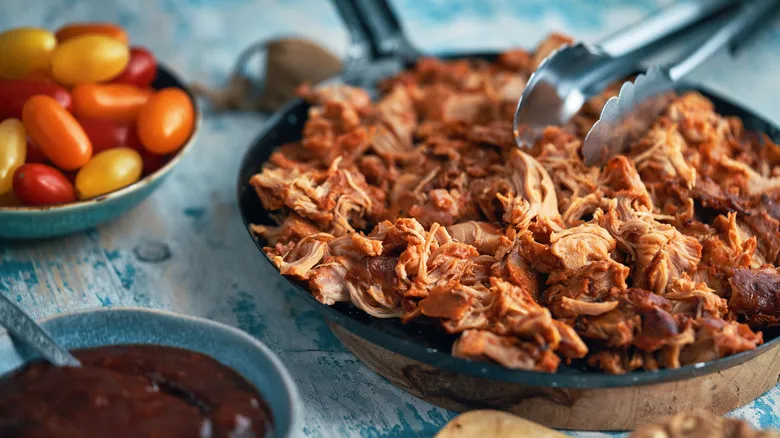
If you're not focused on achieving crispy skin, cooking chicken breast in liquid can be an excellent method. Poaching involves gently cooking in liquid that isn't boiling, which helps keep the meat tender while reducing the need for oil and fat. Poached or simmered chicken can be easily shredded and incorporated into a variety of recipes. Shredded chicken is perfect for tacos, nachos, salads, soups, stews, and chilis.
You can start by quickly searing the breast or sautéing some aromatics in the pan, then add cold broth or water to gently poach or simmer the seasoned chicken breast until fully cooked. Shred the meat using two forks or a KitchenAid attachment. If the remaining liquid is flavorful, you can reduce it and mix it into the pulled chicken for a moist and tasty protein that’s ideal for topping your favorite dishes. This cooking method also maximizes the value of the meat; two breasts can easily serve at least four people.
You can prepare this on the stovetop with a lidded pan or in a slow cooker for a low-and-slow approach that can simmer all afternoon while you go about your day. Other recipes that involve cooking chicken in liquid, such as curries or ginger chicken jook rice porridge, may not specifically instruct you to shred the meat, but they will also produce tender, flavorful, and easily fall-apart chicken.
Dry or wet brine your chicken before cooking

Salting meat involves a bit of science, and surprisingly, you can season larger cuts of chicken earlier than you might expect. Salt extracts moisture, so it's important to allow the meat time to absorb both the moisture and the salt, enhancing its flavor before cooking. Well-seasoned meat will be significantly more flavorful and juicier compared to meat that is seasoned just before serving. The next time you buy chicken breasts, consider salting them up to a full day in advance. Simply take them out of their packaging, pat them dry, season with kosher salt, and return them to the fridge until you're ready to cook. This technique is often referred to as dry brining.
Alternatively, you can wet brine your chicken in a saltwater solution. This method is quicker but may not be suitable for water-chilled chicken. The most basic brine consists of water and kosher salt, but feel free to add spices or even try a pickle juice marinade the next time you prepare fried chicken. Submerge the chicken pieces in the brine and let them soak for 30 minutes to an hour. Salting in advance significantly boosts the meat's flavor. Just be mindful of the salt quantity (a few teaspoons should suffice) — too much can be overwhelming, while too little won't achieve the desired effect. Also, keep in mind that not all salts have the same level of saltiness.
Marinate chicken overnight
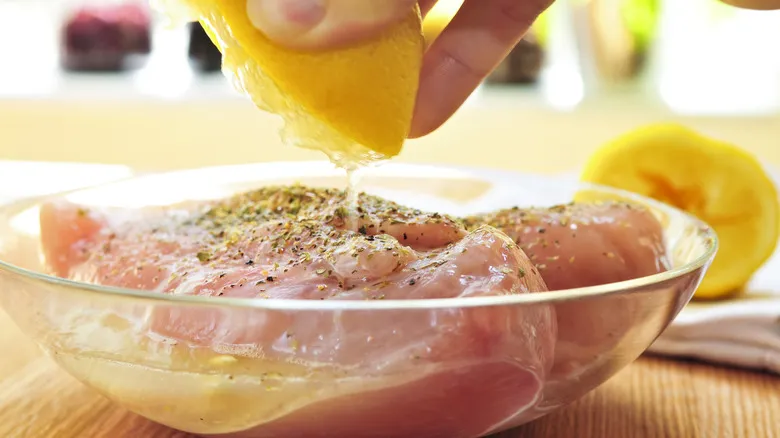
The most effective way to enhance flavor is by marinating chicken breast prior to cooking. While brining will season the meat, marinating infuses a wealth of additional flavors into your dish. Ingredients such as herbs, spices, citrus, and olives penetrate the meat more thoroughly in a marinade compared to simply adding them to the pan right before cooking. A few hours can suffice in a pinch, but marinating overnight will produce the best results. You can marinate bone-in, skin-on chicken breasts before roasting, or cut chicken breast pieces for stir-fries and skewers. Place the chicken in a bowl and cover it, or use a sealed plastic bag to maximize the surface area exposure. Then, refrigerate it and allow it to come to room temperature before cooking the next day.
There is a wide range of marinades available, with recipes from various cultures and cuisines to explore. For instance, marinating chicken in yogurt or buttermilk can make it exceptionally moist and tender. Many Indian recipes, such as tandoori chicken, utilize yogurt and spices for marination. Alternatively, you can create an oil and vinegar marinade with Italian herbs. Mayonnaise also serves as an excellent base for marinades when mixed with flavors like Dijon mustard. A combination of soy sauce, ginger, honey, and miso with oil results in a deliciously sticky and sweet baked chicken, and thighs can be used just as effectively as breasts.
Take it off the heat sooner

One effective method to prevent your chicken breast from becoming dry is to slightly undercook it at the beginning. Yes, you read that correctly. While it's natural to be cautious about raw chicken and the risk of salmonella, we often go too far in the opposite direction. Chicken breasts, more than thighs, tend to become overcooked and unappetizing. By taking the chicken out of your air fryer just a minute or two before it reaches the perfect internal temperature and covering it on the counter, you allow the meat to continue cooking with residual heat, which helps it retain more juices. The USDA advises that different meats should be cooked to specific internal temperatures for safety, with chicken breast needing to reach 165 degrees Fahrenheit. You don’t want to undercook it too much, but if you remove it from the heat around 160 degrees, it will reach the proper temperature while resting before serving.
Similarly, when making certain dishes like stir-fries, you don’t have to keep the chicken in the pan the entire time. Sear the chicken first, then take it off the heat while you sauté your onions and aromatics. Once your flavor base is ready, your curry sauce is started, or your vegetables are softened, you can add the chicken back in to finish cooking. This way, you avoid drying out the meat while waiting for the rest of the dish to come together.
Pound it flat

Pounding or slicing chicken breast into thin cutlets is an excellent method to reduce cooking time. This technique allows you to fry them quickly without risking the outside drying out while waiting for the center to cook through. Additionally, it increases the surface area of the chicken that can absorb seasoning and make contact with the pan. You can either purchase pre-sliced cutlets or easily slice the breast into thin pieces yourself. Another option is to pound the chicken breast between sheets of parchment paper or plastic wrap using a mallet or meat tenderizer. This not only tenderizes the meat but also ensures an even thickness, promoting uniform cooking. While thinner cuts can be more prone to overcooking, keeping a close watch will help you achieve a crispy and juicy cutlet that your whole family will love.
Many classic dishes utilize this technique. For instance, chicken piccata features pounded chicken breast coated in flour, cooked in a sauce made of white wine, lemon, and capers. Chicken schnitzel consists of a thin, breaded cutlet that is fried and often served with potatoes and cranberry sauce. Both recipes are simpler to prepare than you might expect. Feel free to get creative with your cutlets; you can use panko for a delicious chicken katsu or try a cornflake chicken Milanesa for a quick weeknight meal. Leftover breaded chicken can even be transformed into a sandwich for lunch the next day. Just be cautious to avoid common mistakes that can lead to burnt chicken cutlets.
Grill chicken breast right
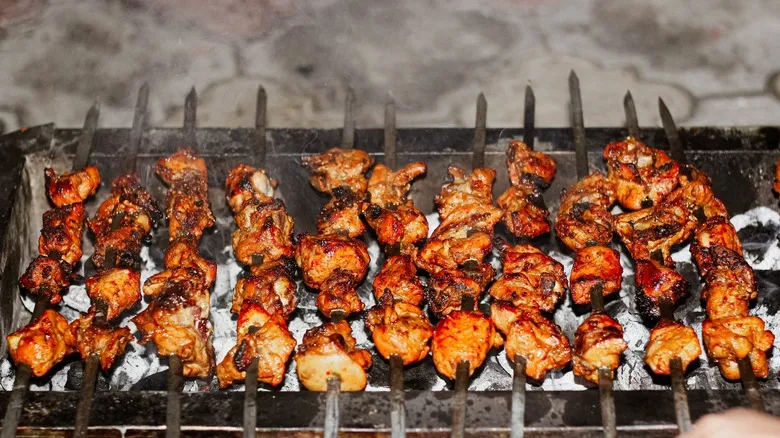
Grilled chicken is a beloved choice for summer meals. While the barbecue is an excellent method for cooking chicken breast, be cautious of this common grilling error: to enhance that smoky flavor and maintain the ideal texture, close the lid after the initial sear. This helps to create a more consistent heat. If you're preparing barbecue chicken with sauce, remember to baste the chicken several times during cooking to keep it moist, and flip the pieces for even cooking. After searing a chicken breast, transfer thicker cuts to the section of the grill with indirect heat to finish cooking with the lid closed. This technique ensures the chicken cooks through without charring the exterior.
Smoky grilled chicken is incredibly tasty, and there are numerous tips for achieving the perfect grilled chicken. First, avoid placing cold meat directly on the grill, as it won't cook evenly; allow it to reach room temperature beforehand. You can grill whole chickens, breasts, or skewers. Regardless of your choice, brining or marinating the meat beforehand will significantly enhance its flavor and juiciness. Additionally, be sure to pat the meat dry before placing it on the grill to achieve a nice crisp. A helpful tip for making kebabs is to soak wooden skewers in water on a shallow tray before adding the meat or vegetables. This will help prevent the exposed wood from burning on the grill.
Prick the chicken breast first
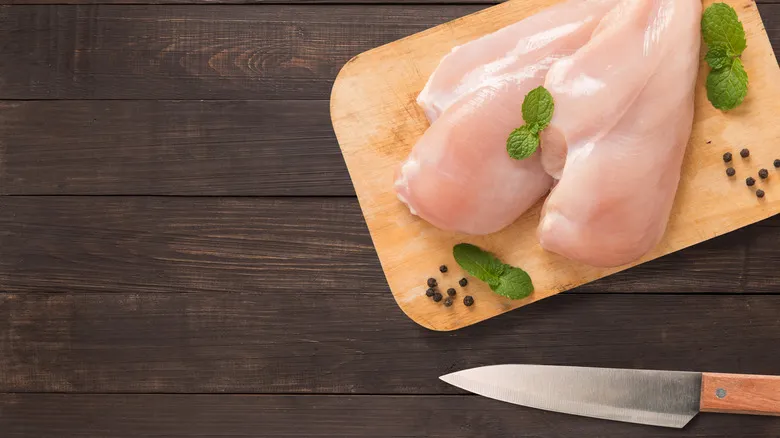
A simple method to enhance the flavor of chicken breast is to create a few holes in it. By doing so before cooking, the seasoning can better penetrate the meat. You can achieve this by gently pricking the surface with a fork or making small cuts with a sharp paring knife. This technique opens up more channels for the seasoning to infuse the meat effectively.
Be careful not to cut all the way through; just make a few small punctures in the flesh before applying your salt, spice rub, or marinade, and you'll notice a significant improvement. Additionally, consider lifting the skin of the chicken breast and sprinkling salt underneath. This allows the salt to reach the meat more easily without having to go through the fatty skin. Don’t forget to season the skin as well to ensure it crisps up beautifully.
Recommended
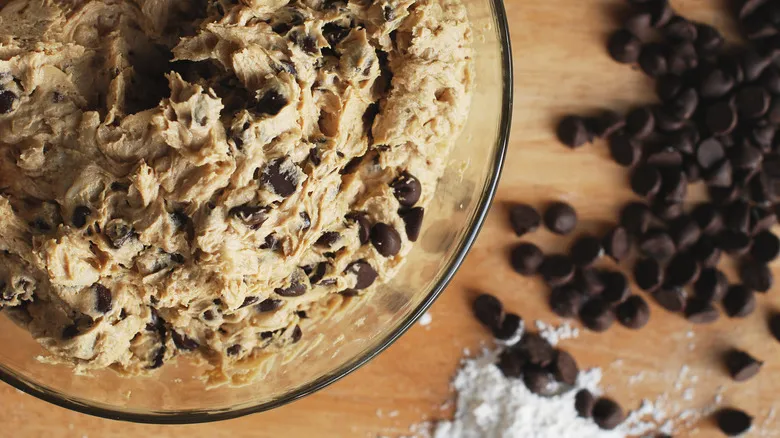
Why Egg-Free Cookie Dough Is Still Unsafe To Eat Raw

The Simple Fix For Overwhipped Cream

The Rinsing Hack To Sort Out The Sweetest Blueberries In The Pack

Make An Unforgettable Tuna Melt With An Easy Bread Swap
Next up

